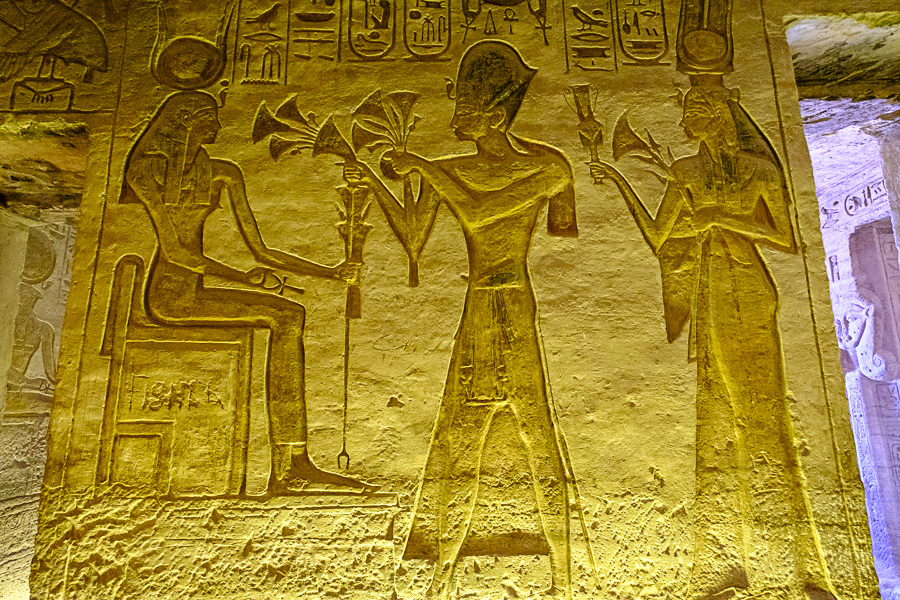This is the capstone of Egyptian Temples 101 – Abu Simbel. Hatem has been drilling us all the way down Lake Nasser on temple stories, hieroglyphics, symbolism, history. We know the difference (or we’re supposed to know the difference) between a key of life and a papyrus frond. We’re supposed to know how to interpret an offering to a god scene, a gods heaping long life and adulation on the pharaoh scene and a pharaoh victorious at war scene. We know which came first: Ramses II, the Romans, the Christians, the Greeks.
At Abu Simbel guides are not allowed inside the temples; tourists have to do it on their own. It really was fun to go after it without Hatem there to Shepard us around. He really did teach us well.
Abu Simbel was constructed in the 13th century but became buried in sand. The temples weren’t “discovered” until the early 19th century until a German explorer noticed the top of one of the statues poking through the sand.
The big deal at Abu Simbel is actually not the inner sanctums. You’ve seen one wall carving of Ramses stabbing one enemy while stepping on another and grinding his nose into the ground, you’ve seen ‘em all. Don’t get me wrong; these were some of the nicest, must colorful ones we’ve seen. Being buried for all those centuries preserved them well. (The one about him shooting the arrow shows two bows and arrows coming from Ramses’ body. The other bow is the god Amun’s who has joined Ramses in war.)
No, the big deal, and I mean really big deal, at Abu Simbel are the colossal statues outside the two his-and-her temples. Ramses was apparently so much in love with his chief consort, Nefertari (i.e., there was more than one) that he built her a temple all her own right next to his.
Ramses II’s domain extended south beyond Abu Simbel into present day Sudan (the border is about 40 miles south) but it is a significant distance from Ramses II’s headquarters in Thebes (present day Luxor) – about 300 miles and two caaracts as the boat floats. He and his wife visited in the 24th year or his reign.
His temple, the big one, features four statues of himself carved from the wall of a mountain standing at the entrance. Each statue is 66 feet tall. Hers features six statues; each 33 feet tall. There are three statues on either side of the door: one of her flanked by two of him “protecting” her. Total count: Ramses 4, Nefertari 2. In his temple, Nefertari is shown much smaller than Ramses. I love you babe, but don’t get any big ideas; I’m still the pharaoh around here. Actually, in her temple they are shown as equal in size. She must have been some fine consort.
Both temples had to be moved in the 1960s as the waters of Lake Nasser rose. It was a close thing; a dam had to be constructed around the temples so they could be moved up the hill a few hundred yards. Because the exterior statues were not freestanding, but rather had been carved from the face of a mountain, they had to build a new artificial mountain. The statues were cut off in pieces and then glued back on the face of the new mountain. Not only that, but the original temples had been designed so that the sun’s rays shone through a slit so as to illuminate statues inside on a particular day in October and March to fall on four interior statues (but not a fifth, an out of favor gud). The new arrangement had to have the same orientation.
After our afternoon visit, we returned to the ship for a brief rest then turned right around and went back for a light show and then dinner at 7:45 PM.
Earlier, as we sailed toward Abu Simbel, we passed by Kasdr Ibrim, the only remaining Nubian building that survived Lake Nasser. It’s a fallen down fort that later on was used as a mosque.
Tomorrow is moving day: 5:30 AM alarm, breakfast starts at 6, bags out by 6:30, on the bus at 7 for a 3.5 hour trip to Aswan. We visit a Nubian museum, board our Nile cruise boat for lunch at 1 PM and then a felucca ride in the afternoon. Never a dull moment!







































